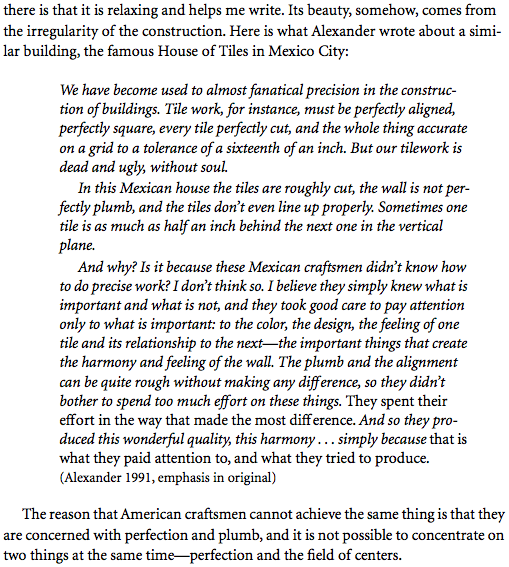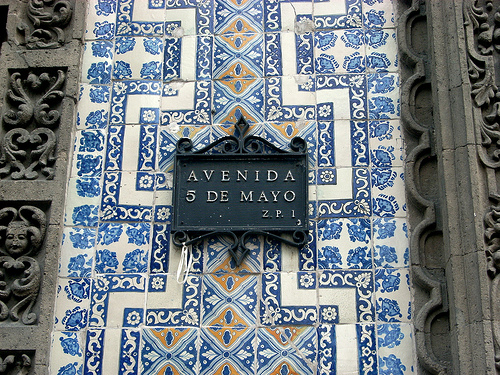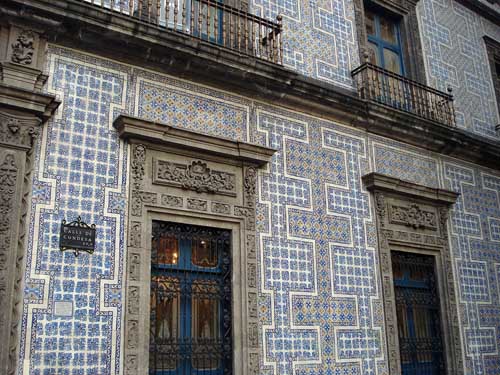Christopher Alexander on the beauty and sense of wholeness that comes from the irregular construction of buildings such as La Casa de los Azulejos in Mexico City. From his 1991 essay “The Perfection of Imperfection,” as cited by Richard Gabriel in Patterns of Software (1.2 MB PDF).





Anon B.
on 22 Jun 09One could almost think that this was a comment on the change that cyclingnews underwent recently. The previous design obviously had it’s imperfections, but it also had personality and small touches that only made sense after using the site for a while. It was also a design that maintained an old heritage. For those interested – check out the rage in the forums.
====
On a more general note, what is interesting is that some “designs” (be it architecture or web sites) are more forgiving to aesthetic imperfections (such as the un-aligned tiles) than others. A website (or building) where everything lines up pixel-perfectly, as soon as something is just slightly malplaced the entire thing collapses – while other designs almost craves imperfectness.
Jon
on 22 Jun 09I have been inspired.
By concentrating on what matters and letting the rest fall where it may, there is either more time to move on to another project, or more time to devote to the aspects of the design that are meaningful. Simple, and effective.
GeeIWonder
on 22 Jun 09The building is about twice as old as the USA itself, and Mexico city is ‘sinking’. Think either of those may play a part here?
Nah, can’t be. They were focused on what was important—making their point with blinders on.
nickd
on 22 Jun 09Does anybody have a link to the original Alexander essay? Am having a hard time finding it.
mr.negative
on 22 Jun 09That facade looks like my nephew’s macaroni art.
Craftmanship is execution. This clown is obfuscating logic with his personal esthetic.
SS
on 22 Jun 09@nickd – It’s very short. I wasn’t able to find it online, but it’s included in an essay collection called Roots and Branches.
Happy
on 22 Jun 09Myself, I love the aesthetic of clean, crisp lines and products that are built with tight tolerances. I believe in “to each his own” which is why it’s nonsense and presumptuous for Alexander to declare that he knows what’s important and what’s not. Especially when it comes to buildings and homes, there’s no way he can presume to know what is important to me or to any building client.
EWatson
on 22 Jun 09This is shaping up to be an interesting debate.
On the one hand, Alexander argues that color, design, harmony and feelings are important, and alignment and industrial consistency with close measurement tolerances are better left by the way.
On the other hand, some commenters are arguing that alignment and industrial consistency with close measurement tolerances are the most important things, and color and design are superfluous and can go by the way. I suppose those with this view would recommend going ahead and making precision and clean design one’s aesthetic, to save aggravation and wasting of time.
I remember studying a similar argument once in college when I wrote a paper on Frank Lloyd Wright vs. the Bauhaus. I guess neither one has won yet.
Jeff Foster
on 22 Jun 09I think all Americans should have the experience in life of living in a foreign country and assimilate themselves into a different culture until they truly learn to appreciate the beauty of imperfection, for to me, it is far more real and enjoying than the robotic, obsessively perfectionist standards that box us in.
I’ve fortunately had the opportunity to live outside the USA long enough to be taught to appreciate reality, and the soul found in its imperfections.
John
on 22 Jun 09Truve..
GeeIWonder
on 22 Jun 09On the other hand, some commenters are arguing that alignment and industrial consistency with close measurement tolerances are the most important things, and color and design are superfluous and can go by the way. I
Where?
Paul
on 22 Jun 09-James Agee, Let Us Now Praise Famous Men
Alex Berenyi
on 23 Jun 09Hard to define the qualities Alexander perceives and celebrates… he has written all his life in the attempt. The perennially brave new world of modernism has no patience for the past, for the irregularities of craftsmanship and tradition, for slow evolution of building styles and city neighborhoods, for textured human scale. New, not mature, and impatiently hungry for novelty, for recognition, to play with new materials and new forms, to cast off the past and all constraint… yet without constraint there cannot be design, because design needs careful understanding and working with constraints. Alexander is out of fashion because he has neither interest nor patience with those who follow fashion. Learn, if you can, from those mature enough to slowly and carefully love and embrace constraints.
Christopher
on 23 Jun 09I always appreciate your occasional Alexander reference. It was right here that I first learned of him years ago, and he may well be the most significant artistic inspiration in my life. I’m fortunate you didn’t keep him all to yourself. Thanks!
Tathagata Chakraborty
on 23 Jun 09Thanks for the link to the book “Patterns of Software”!
It is important to include some imperfection aesthetic to a thing so that it accentuates the perfection of something else (apart from just art’s sake). For a software example take the case of Mac OS X font rendering, which compared to that in Windows is blurry. But that blurriness actually accentuates the clear sharp lines, the brushed metal look and the sharp icons of the GUI. Hope, this makes sense :)
Sean
on 23 Jun 09Ha. I guess that’s the point of this post. It’s not about logic. But it’s not about aesthetic either, really. Of course, this building is beautiful.
But the same rule would apply to your run-of-the-mill suburban sprawl home. Though in that case, I guess you would want everything to line up perfect so you could believe the lie that it’s a well built house and won’t fall apart in 70 years.
But how would this apply to my code? Does it mean that I should stop wasting time about getting it just right and get the damn thing finished and working? Over time, do I get really good at building sites/apps really fast and well-crafted?
B/c you’re not going to build the Casa Azul your first time around.
indi
on 23 Jun 09There is beauty in both precision and chaos. Nature certainly has both in her palette.
John Blackburn
on 24 Jun 09The English art critic John Ruskin-an influence on Alexander, I believe-was a huge proponent of aesthetic imperfection:
“No good work whatever can be perfect, and the demand for perfection is always a sign of a misunderstanding of the ends of art. “
Also makes me think of the Scottish architect, Charles Rennie Mackintosh, who also decried geometric perfection:
“There is hope in honest error. None in the icy perfection of the mere stylist. “
Debajit Adhikary
on 26 Jun 09Anyone know what font/typeface is used in the quoted snippet above? I’m very curious to know—seems very nice to me. (Looks a little like Minion Pro.)
This discussion is closed.